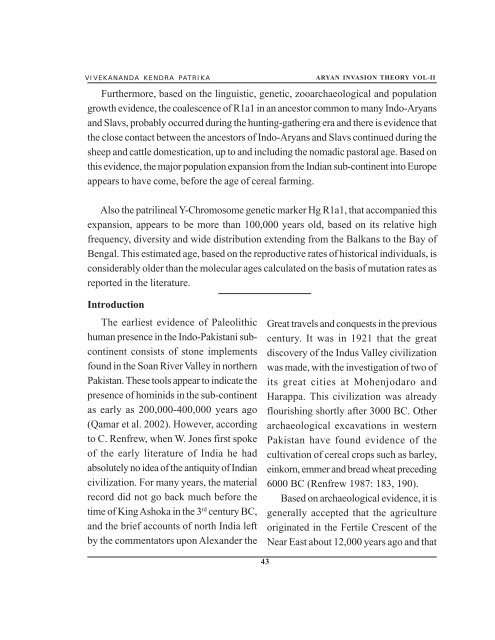Aryan Invasion Theory - Publication - Vivekananda Kendra
Aryan Invasion Theory - Publication - Vivekananda Kendra
Aryan Invasion Theory - Publication - Vivekananda Kendra
Create successful ePaper yourself
Turn your PDF publications into a flip-book with our unique Google optimized e-Paper software.
VIVEKANANDA KENDRA PATRIKA ARYAN INVASION THEORY VOL-II<br />
Furthermore, based on the linguistic, genetic, zooarchaeological and population<br />
growth evidence, the coalescence of R1a1 in an ancestor common to many Indo-<strong>Aryan</strong>s<br />
and Slavs, probably occurred during the hunting-gathering era and there is evidence that<br />
the close contact between the ancestors of Indo-<strong>Aryan</strong>s and Slavs continued during the<br />
sheep and cattle domestication, up to and including the nomadic pastoral age. Based on<br />
this evidence, the major population expansion from the Indian sub-continent into Europe<br />
appears to have come, before the age of cereal farming.<br />
Also the patrilineal Y-Chromosome genetic marker Hg R1a1, that accompanied this<br />
expansion, appears to be more than 100,000 years old, based on its relative high<br />
frequency, diversity and wide distribution extending from the Balkans to the Bay of<br />
Bengal. This estimated age, based on the reproductive rates of historical individuals, is<br />
considerably older than the molecular ages calculated on the basis of mutation rates as<br />
reported in the literature.<br />
Introduction<br />
The earliest evidence of Paleolithic<br />
human presence in the Indo-Pakistani subcontinent<br />
consists of stone implements<br />
found in the Soan River Valley in northern<br />
Pakistan. These tools appear to indicate the<br />
presence of hominids in the sub-continent<br />
as early as 200,000-400,000 years ago<br />
(Qamar et al. 2002). However, according<br />
to C. Renfrew, when W. Jones first spoke<br />
of the early literature of India he had<br />
absolutely no idea of the antiquity of Indian<br />
civilization. For many years, the material<br />
record did not go back much before the<br />
time of King Ashoka in the 3rd century BC,<br />
and the brief accounts of north India left<br />
by the commentators upon Alexander the<br />
43<br />
Great travels and conquests in the previous<br />
century. It was in 1921 that the great<br />
discovery of the Indus Valley civilization<br />
was made, with the investigation of two of<br />
its great cities at Mohenjodaro and<br />
Harappa. This civilization was already<br />
flourishing shortly after 3000 BC. Other<br />
archaeological excavations in western<br />
Pakistan have found evidence of the<br />
cultivation of cereal crops such as barley,<br />
einkorn, emmer and bread wheat preceding<br />
6000 BC (Renfrew 1987: 183, 190).<br />
Based on archaeological evidence, it is<br />
generally accepted that the agriculture<br />
originated in the Fertile Crescent of the<br />
Near East about 12,000 years ago and that

















